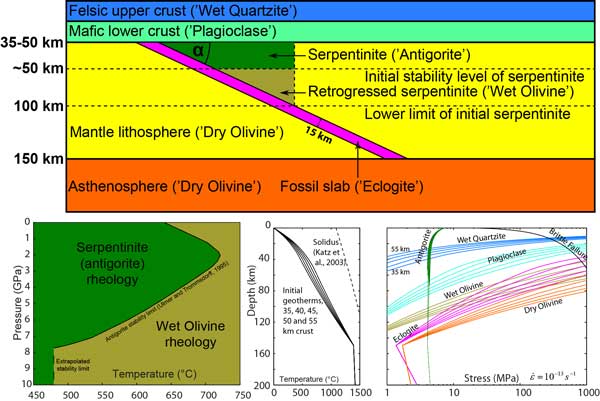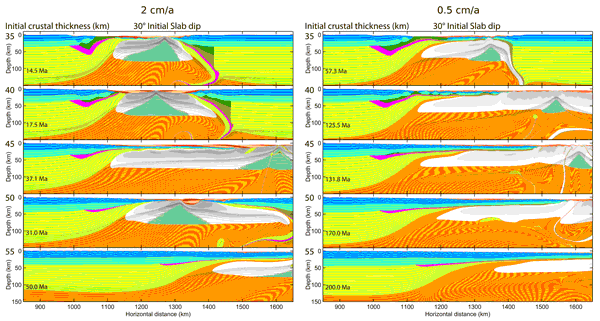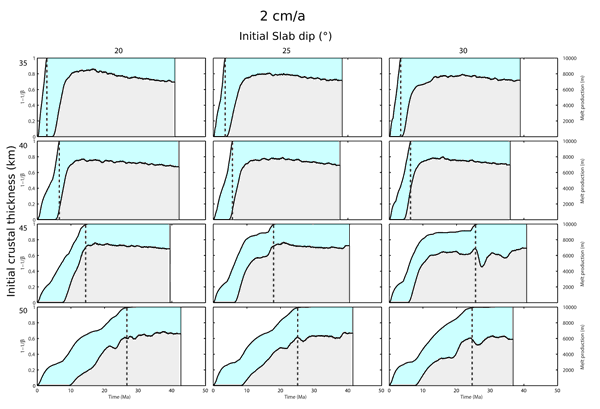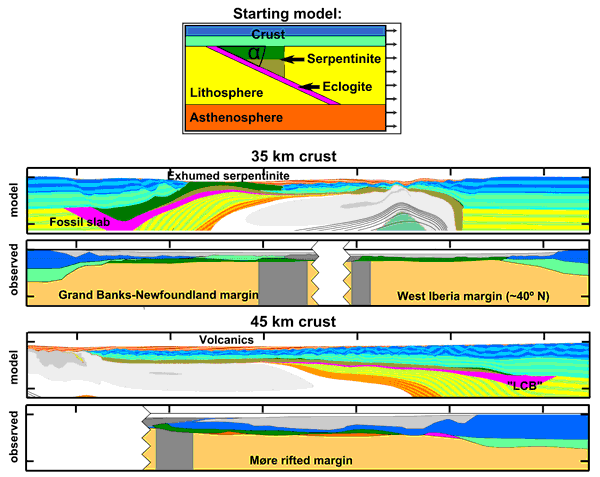 |
Orogenic inheritance and continental breakup: Wilson Cycle-control on rift and passive margin evolution |
Kenni D. Petersen1 & Christian Schiffer1,2
1Department of Geoscience, Aarhus University, 8000 Aarhus, Denmark; kenni@geo.au.dk
2Department of Earth Sciences, Durham University, Durham DH1 3LE, United Kingdom; christian.schiffer@durham.ac.uk
This webpage is a summary of: Petersen, K.D., and Schiffer, C., 2016, Wilson cycle passive margins: Control of orogenic inheritance on continental breakup: Gondwana Research, 39, 131-144, doi: 10.1016/j.gr.2016.06.012
Introduction
Rifting and continental break-up often occur along old suture zones of previously collided continents as part of the Wilson cycle (Wilson, 1966; Dewey & Spall, 1975). Although it is generally appreciated that extension and break-up is controlled by orogenic inheritance (Dunbar & Sawyer, 1989; Williams, 1995; Buiter & Torsvik, 2014), the physical mechanisms that govern how the evolution of rifts and passive margins are affected by pre-rift structures are not well understood. In the North Atlantic the axis of rifting and break-up are generally strike-parallel to the Caledonian-Variscan- and Grenvillian orogenies suggesting ancestral control of orogenic inheritance (Williams, 1995; Thomas, 2006; Schiffer et al., 2015).
We use thermo-mechanical modelling to investigate the effect of preserved orogenic structures during rifting and continental break-up. Such inherited structures include:
- Thickened crust;
- Eclogitized oceanic crust emplaced in the mantle lithosphere; and
- Mantle wedge of hydrated peridotite (serpentinite).
Passive margin structure in the North Atlantic
Passive continental margins are often discriminated in terms of the volume of igneous rocks emplaced during thinning of the continental crust (Franke, 2013). The Iberia-Newfoundland conjugate margins represent a magma-poor example where rift-related igneous rocks are sparse (Minshull et al., 1998) and continental crustal slivers (Péron-Pinvidic & Manatschal, 2010) are separated from the margin by exhumed and serpentinised mantle (Boillot et al., 1988). Magma-rich passive margins, such as the Greenland-Scotland/Norway margins, contain abundant rift/breakup-related igneous rocks in the form of basalt flows or lower-crustal intrusions (White, 1992; Coffin & Eldholm, 1994; Eldholm & Grue, 1994; Menzies et al., 2002; Geoffroy, 2005). An apparent difference between magma-rich and magma-poor margins is that the onset of melt production precedes or follows continental break-up: Magma-poor margins produce no or little magma before and during breakup, followed by an amagmatic phase of mantle exhumation before oceanic crust begins to be produced. In contrast, magma-rich margins generally produce substantial melt before and during break-up that are emplaced on and in the continental crust.
High-velocity lower-crustal (HVLC) bodies with higher than normal crustal and sometimes also mantle seismic velocities and densities are a common feature of passive margins. These are often explained by intrusion or “underplating” by rift-related magmatic products (Olafsson et al., 1992; Thybo & Artemieva, 2013). Other explanations include orogenic metamorphic remnants (Gernigon et al., 2006; Mjelde et al., 2013), syn-rift hydrated mantle (Ren et al., 1998; Mjelde et al., 2002) or preserved subduction-related serpentinite (Fichler et al., 2011; Schiffer et al., 2016). Because of the very similar seismic properties of these materials they are potentially difficult to distinguish with geophysical methods (Mjelde et al., 2002).
Numerical modelling
Fossil subduction and suture zones are observed globally and originate from as far back as the Archean (Balling, 2000; van der Velden & Cook, 2005). Their seismic signature is often indicative of eclogitised subducted crust (Morgan et al., 2000; Hansen & Balling, 2004; Gorman et al., 2006; Schiffer et al., 2015). Serpentinised mantle wedges observed in contemporary subduction zones (Bostock, 2013) may “survive” orogenesis and rifting while staying within the stability limits (Ulmer & Trommsdorff, 1995).
In view of these factors, we set up a numerical model comprising a simple, two-layered crust with upper and lower crustal rheology, a dipping eclogite layer and a hydrated mantle wedge (Figure 1). Antigorite rheology is assumed within its stability limits, and “wet olivine” rheology otherwise.

Figure 1: a, Initial model setup. b, Stability limit for serpentinite. c, Initial lithosphere geotherms for different crustal thicknesses. Dashed line indicates assumed pressure-dependent solidus for fertile asthenospheric mantle (Katz et al., 2003). d, Constant strain rate (10-13 s-1) stress profiles for ductile creep in the different lithologies employed in this study. Different curves for each lithology show the effect of different initial crustal thickness (corresponding to geotherms shown in c). Black line indicates brittle yield stress.
We tested a number of different models with varying crustal thickness (35-55 km), varying dip angle of the high-velocity layer (20-30°, only 30° shown in Figure 2) and a fast and a slow extension rate (2 cm/a, 0.5 cm/a). We conducted 2D geodynamic modelling using a multigrid based (Petersen et al., 2015) marker-in-cell method (Gerya & Burg, 2007).

Figure 2: Models with extension rates of 2 cm/a (left) and 0.5 cm/a (right) and different crustal thicknesses at an initial dip angle of the fossil subduction zone of 30°. The panels show stages corresponding to either 10 Ma after continental breakup (defined as the time when the crustal thinning factor, β, somewhere exceeds 100) or at the 50 Ma and 200 Ma maximum simulation times for fast and slow extension rates, respectively. Light blue indicates the active melt-producing zone in the mantle, and grey tones indicate where mantle melting has occurred at some stage. Different grey tones represent 5% intervals of melt depletion, increasing with decreasing brightness. Topmost layers with salmon/orange colors are volcanics deposited at the surface. Color changes within the volcanics represent isochrons spaced at 5 Ma. Click here or on Figure for enlargment.
Mantle or crustal flow
The models indicate that the presence of inherited orogenic structures not only defines the location of rifting upon extension but also controls the structural and magmatic evolution of the developing passive margins (Figures 2 & 3). Rifts developing in thin initial crust can preserve large amounts of pre-rift orogenic serpentinite. This facilitates rapid continental break-up and exhumation of hydrated mantle prior to the onset of magmatism. In contrast, rifts in thicker crust develop more focused thinning in the mantle lithosphere rather than in the crust and continental break-up is preceded by magmatism as a consequence. This implies that whether passive margins become magma-poor or magma-rich is a function of pre-rift orogenic properties.

Figure 3: Stretch factor 1-1/β (blue) and integrated melt production thickness (greyish pink) as functions of model time for all models with extension rates of 2 cm/a. Slab-dip angle varies along the x-axis (20°, 25°, 30°) and crustal thickness varies along the y-axis (35 km, 40 km, 45 km, 50 km). Vertical dashed line corresponds to the time of continental breakup. Click here or on Figure for enlargment.
The models show that structures of orogenic eclogite and hydrated mantle are partially preserved during rifting and emplaced either at the base of the thinned crust or within the lithospheric mantle as dipping structures. The former provides an alternative interpretation of of the widespread ‘lower crustal bodies’ which are often regarded as igneous. The latter may correspond to the dipping sub-Moho reflectors often observed in passive margins. Figure 4 summarises the main results of our paper by comparing two of the models–with thin and thick crust–with examples from the Iberia-Newfoundland and the Norwegian passive margins, respectively.

Figure 4: 2D numerical modelling setup and results. Rifting and break-up of lithosphere with thin initial continental crust results in magma-poor margins, whereas thick initial continental crust results in magma-rich passive margins.
Conclusions
- Pre-existing orogenic structures, including fossil subduction zones, and crustal thickness can control the structural and magmatic evolution of passive margins.
- Serpentinite in distal zones of magma-poor margins may be explained by exhumation of pre-rift orogenic mantle-wedge material.
- Similarly, fossil mantle wedge material can become emplaced at the base of thinned continental crust to form a crustal “underplate”.
- Fossil slab material entrained in the lithospheric mantle at the onset of extension can either “survive” extension and break apart passively to form two conjugate dipping structures in the upper mantle, or become sheared along the Moho beneath the “hanging wall”. This may explain some of the high-velocity bodies at the base of the crust.
- Crustal thickness is an important control on the relative timing of melting and crustal breakup. Thicker crust enhances thinning in the mantle lithosphere compared to the crust and decompression melting is more likely to onset before continental break-up. In contrast, thin crust breaks more easily than mantle lithosphere, promoting exhumation of pre-rift hydrated mantle and the starting of decompression melting after continental break-up.
- Hyperextension, by means of extremely thinned continental crust, can be explained by crustal flow and pronounced rift delocalization in thick continental crust.
References
-
Balling, N., 2000, Deep seismic reflection evidence for ancient subduction and collision zones within the continental lithosphere of northwestern Europe: Tectonophysics, 329, 269-300, doi: 10.1016/S0040-1951(00)00199-2.
-
Boillot, G., Girardeau, J., and Kornprobst, J., 1988, Rifting of the Galicia margin: crustal thinning and emplacement of mantle rocks on the seafloor: Proc. Sci. Res., ODP, Leg 103, Galicia Margin, 741-756.
-
Bostock, M.G., 2013, The Moho in subduction zones: Tectonophysics, 609, 547-557, doi: 10.1016/j.tecto.2012.07.007.
-
Buiter, S.J.H., and Torsvik, T.H., 2014, A review of Wilson Cycle plate margins: A role for mantle plumes in continental break-up along sutures? Gondwana Research, 26, 627-653, doi: 10.1016/j.gr.2014.02.007.
-
Coffin, M.F., and Eldholm, O., 1994, Large igneous provinces: Crustal structure, dimensions, and external consequences: Reviews of Geophysics, 32, 1-36, doi: 10.1029/93RG02508.
-
Dewey, J., and Spall, H., 1975, Pre-Mesozoic plate tectonics: How far back in Earth history can the Wilson Cycle be extended? Geology, 3, 422-424, doi: 10.1130/0091-7613(1975)3<422:PPTHFB>2.0.CO;2.
-
Dunbar, J.A., and Sawyer, D.S., 1989, How preexisting weaknesses control the style of continental breakup: Journal of Geophysical Research, 94, 7278-7292, doi: 10.1029/JB094iB06p07278.
-
Eldholm, O., and Grue, K., 1994, North Atlantic volcanic margins: Dimensions and production rates: Journal of Geophysical Research, 99, 2955-2968, doi: 10.1029/93JB02879.
-
Fichler, C., Odinsen, T., Rueslåtten, H., Olesen, O., Vindstad, J.E., and Wienecke, S., 2011, Crustal inhomogeneities in the Northern North Sea from potential field modeling: Inherited structure and serpentinites? Tectonophysics, 510, 172-185, doi: 10.1016/j.tecto.2011.06.026.
-
Franke, D., 2013, Rifting, lithosphere breakup and volcanism: Comparison of magma-poor and volcanic rifted margins: Marine and Petroleum Geology, 43, 63-87, doi: 10.1016/j.marpetgeo.2012.11.003.
-
Geoffroy, L., 2005, Volcanic passive margins: Comptes Rendus Geoscience, 337, 1395-1408, doi: 10.1016/j.crte.2005.10.006.
-
Gernigon, L., Lucazeau, F., Brigaud, F., Ringenbach, J.-C., Planke, S., and Le Gall, B., 2006, A moderate melting model for the Vøring margin (Norway) based on structural observations and a thermo-kinematical modelling: Implication for the meaning of the lower crustal bodies: Tectonophysics, 412, 255-278, doi: 10.1016/j.tecto.2005.10.038.
-
Gerya, T.V., and Burg, J.-P., 2007, Intrusion of ultramafic magmatic bodies into the continental crust: Numerical simulation: PEPI, 160, 124-142, doi: 10.1016/j.pepi.2006.10.004.
-
Gorman, A.R., Németh, B., Clowes, R.M., and Hajnal, Z., 2006, An investigation of upper mantle heterogeneity beneath the Archaean and Proterozoic crust of western Canada from Lithoprobe controlled-source seismic experiments: Tectonophysics, 416, 187-207, doi: 10.1016/j.tecto.2005.11.023.
-
Hansen, T.M., and Balling, N., 2004, Upper-mantle reflectors: modelling of seismic wavefield characteristics and tectonic implications: Geophysical Journal International, 157, 664-682, doi: 10.1111/j.1365-246X.2004.02217.x.
-
Katz, R.F., Spiegelman, M., and Langmuir, C.H., 2003, A new parameterization of hydrous mantle melting: Geochemistry, Geophysics, Geosystems, 4, 1073, doi: 10.1029/2002GC000433.
-
Menzies, M.A., Klemperer, S.L., Ebinger, C.J., and Baker, J., 2002, Characteristics of volcanic rifted margins: Geological Society of America Special Papers, 362, 1-14, doi: 10.1130/0-8137-2362-0.1.
-
Minshull, T.A., Muller, M.R., Robinson, C.J., White, R.S., and Bickle, M.J., 1998, Is the oceanic Moho a serpentinization front? Geological Society, London, Special Publications, 148, 71-80, doi: 10.1144/GSL.SP.1998.148.01.05.
-
Mjelde, R., Goncharov, A., and Müller, R.D., 2013, The Moho: Boundary above upper mantle peridotites or lower crustal eclogites? A global review and new interpretations for passive margins: Tectonophysics, 609, 636-650, doi: 10.1016/j.tecto.2012.03.001.
-
Mjelde, R., Kasahara, J., Shimamura, H., Kamimura, A., Kanazawa, T., Kodaira, S., Raum, T., and Shiobara, H., 2002, Lower crustal seismic velocity-anomalies; magmatic underplating or serpentinized peridotite? Evidence from the Vøring Margin, NE Atlantic: Marine Geophysical Researches, 23, 169-183, doi: 10.1023/A:1022480304527.
-
Morgan, R.P.L., Barton, P.J., Warner, M., Morgan, J., Price, C., and Jones, K., 2000, Lithospheric structure north of Scotland—I. P-wave modelling, deep reflection profiles and gravity: Geophysical Journal International, 142, 716-736, doi: 10.1046/j.1365-246x.2000.00151.x.
-
Olafsson, I., Sundvor, E., Eldholm, O., and Grue, K., 1992, Møre Margin: Crustal structure from analysis of Expanded Spread Profiles: Marine Geophysical Researches, 14, 137-162, doi: 10.1007/BF01204284.
-
Péron-Pinvidic, G., and Manatschal, G., 2010, From microcontinents to extensional allochthons: witnesses of how continents rift and break apart? Petroleum Geoscience, 16, 189-197.
-
Petersen, K.D., Armitage, J.J., Nielsen, S.B., and Thybo, H., 2015, Mantle temperature as a control on the time scale of thermal evolution of extensional basins: Earth and Planetary Science Letters, 409, 61-70, doi: 10.1016/j.epsl.2014.10.043.
-
Ren, S., Skogseid, J., and Eldholm, O., 1998, Late Cretaceous-Paleocene extension on the Vøring Volcanic Margin: Marine Geophysical Researches, 20, 343-369, doi: 10.1023/A:1004554217069.
-
Schiffer, C., Balling, N., Ebbing, J., Jacobsen, B.H., and Nielsen, S.B., 2016, Geophysical-petrological modelling of the East Greenland Caledonides - Isostatic support from crust and upper mantle: Tectonophysics, doi: 10.1016/j.tecto.2016.06.023.
-
Schiffer, C., Jacobsen, B.H., Balling, N., Ebbing, J., and Nielsen, S.B., 2015, The East Greenland Caledonides—teleseismic signature, gravity and isostasy: Geophysical Journal International, 203, 1400-1418, doi: 10.1093/gji/ggv373.
-
Schiffer, C., Stephenson, R.A., Petersen, K.D., Nielsen, S.B., Jacobsen, B.H., Balling, N., and Macdonald, D.I.M., 2015, A sub-crustal piercing point for North Atlantic reconstructions and tectonic implications: Geology, 43, 1087-1090, doi: 10.1130/G37245.1.
-
Thomas, W.A., 2006, Tectonic inheritance at a continental margin: GSA Today, 16, 4-11.
-
Thybo, H., and Artemieva, I.M., 2013, Moho and magmatic underplating in continental lithosphere: Tectonophysics, 609, 605-619, doi: 10.1016/j.tecto.2013.05.032.
-
Ulmer, P., and Trommsdorff, V., 1995, Serpentine stability to mantle depths and subduction-related magmatism: Science, 268, 858-861, doi: 10.1126/science.268.5212.858.
-
van der Velden, A.J., and Cook, F.A., 2005, Relict subduction zones in Canada: Journal of Geophysical Research: Solid Earth, 110, n/a-n/a, doi: 10.1029/2004JB003333.
-
White, R.S., 1992, Crustal structure and magmatism of North Atlantic continental margins: Journal of the Geological Society, 149, 841-854, doi: 10.1144/gsjgs.149.5.0841.
-
Williams, H. (Ed.), 1995, Geology of the Appalachian-Caledonian Orogen in Canada and Greenland: Geol. Surv. Canada, Geology of Canada Series 6, 1995; 944 pp, https://doi.org/10.4095/205242
-
Wilson, J.T., 1966, Did the Atlantic close and then re-open? Nature, 211, 676-681, doi: 10.1038/211676a0.
last updated 30th
June, 2017 |
